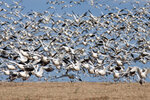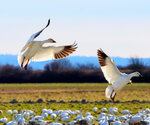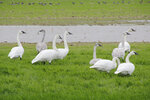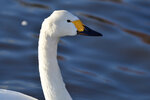




Following my own advice from an early January column, this past weekend, a friend and I drove up to the Skagit Flats, southwest of the town of Mount Vernon. My friend had never seen Snow Geese or the swans that also winter on the flats.
At first, we saw ducks and swans, but no geese. Then, in the early afternoon, a huge flock of Snow Geese (at least 10,000, but probably more) flew in from the south. Driving over the back roads, we followed the circling flock as they settled on a green hay field near the corner of Best Road and Calhoun Road, east of the town of La Conner.
We settled on the side of the road to watch and listen. Geese never stop cackling, and what a racket 10,000 of them make as they graze, slowly moving across the field as they eat.
Earlier, we had received advice from one of the locals to keep the windows closed when the geese fly over. Why? Well, have you ever heard the expression “as fast as grass through a goose”? These grazing geese are renowned for releasing their grassy feces as they fly, and when 10,000+ individuals fly over, it can have “impressive” results.
After about half an hour, for no obvious reason, the geese started to rise, first a few and then the whole flock, constantly cackling to each other and slowly circling. My friend was overwhelmed by the sight of 10,000 birds filling the sky, swooping and swerving in unison, breaking into groups and then merging again in an epic aerial ballet.
Then, the whole flock settled back to earth, more or less in the same place. Like the people in several cars behind us, we collected our wits and moved on.
This amazing Snow Goose drama plays out in winter along both the Pacific and Atlantic coasts. Snow Geese winter in huge numbers in the California valleys, visiting the fallow rice fields. Back east, the Chesapeake Bay and other areas also host thousands of Snow Geese. Apparently, hanging out together provides protection from predators. But what predators?
The only ones we observed in the Skagit Flats this trip were Bald Eagles. We saw close to 50 of them, most sitting as singles or pairs on lofty perches. These eagles have a well-documented pattern to their hunting. Usually, they cannot fly fast enough to take a healthy duck or goose. Rather, they will from time to time “buzz” a flock, putting it in the air and then looking for weaklings or injured birds (remembering that hunting is also ongoing in the Skagit Flats in winter). They only need to find one or two every day to remain healthy and well-fed.
Bald Eagles are famous for taking advantage of whatever food source is available, including sometimes stealing food from a smaller predator. In cattle country, including range areas of Eastern Washington, eagles gather in early spring during the cattle birthing season. They feed on the afterbirth as well as stillborn calves. The same occurs in sheep-rearing areas.
In addition to the Snow Geese and Bald Eagles, we were amazed by the large numbers of wintering swans. There were both species, Trumpeter and Tundra Swans, with Trumpeters outnumbering the latter about 10 to 1. The swans are found in smallish flocks (roughly 4 to 20) in many places, including right along the road. If you can manage to park quietly, you can study these birds all you want. The ones with yellow toward the back of their bills are the Tundra Swans. And notice the swans as they fly – they’re majestic. While you are looking for swans, you will see lots of eagles who are also looking for swans.
If you want to try Skagit Flats, you can do it in a day trip or an overnight in La Conner or other nearby location. The Snow Geese usually depart in early to mid-March, about the time the valley’s daffodil fields break into bloom.
Look on any map display for Best Road, running north/south through the area. (It was probably named after some old-time settler but, for birders, it is the best road). Drive this road and the perpendicular and parallel roads. Sometimes, a large Snow Goose flock will look like a snow-covered field from a distance. Once you find them, be patient. And be ready to shut your windows!
George Walter is the environmental program manager at the Nisqually Indian Tribe’s natural resources department; he also has a 40+ year interest in bird watching. He may be reached at george@theJOLTnews.com
Photos for this column are provided by Liam Hutcheson, a 16-year-old Olympia area birder and avid photographer.
Editors note: Edit to fix the mistaken time of year in the paragraph about eagles gathering. 1-26-2024 3:43 p.m.
4 comments on this item Please log in to comment by clicking here
mckirgan1239
Loved this article George, thank you for sharing and doubt I will ever get up in that area but reading your article was almost as good! I just felt amazed at your description of the beautiful geese, their sound and the size of the flock. You took me on the trip. Thanks Again, Sally McKirgan
Friday, January 26 Report this
marygentry
George- this took me back to a trip we made to this magical place several years ago. I could hear the geese cackling as I read our report. Glad you were able to share this experience with a friend who had not witnessed this before. We have often had some luck with swan and geese sightings this time of year driving toward Elma. Mary
Friday, January 26 Report this
JudithB
Good reminder of something fun and fabulous for us to do and see this monsoon season! And well written. Thank you George
Friday, January 26 Report this
KerriG
Great story. Thanks. I think I saw snow geese in a field in Auburn about two weeks ago. But there were just a few of them so maybe they were swans. This is a field that the Canadian Geese feed in all the time. I was surprised to see them so far south as I had never seen them in Auburn before.
Friday, January 26 Report this